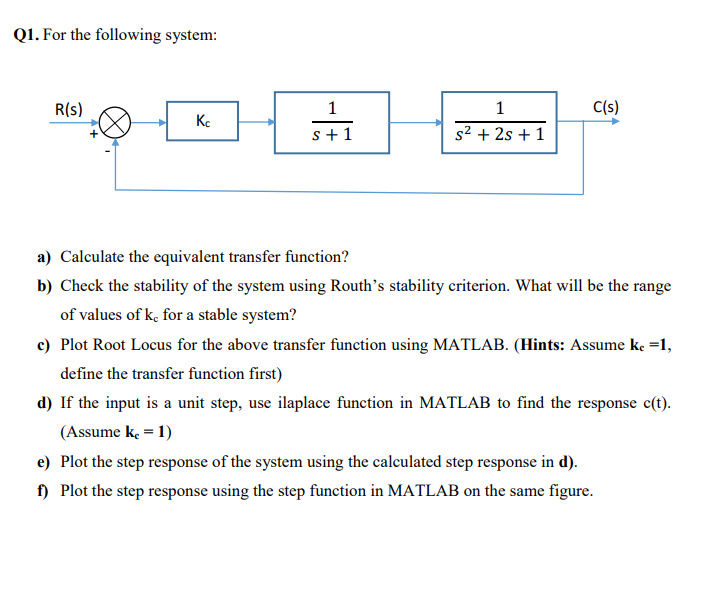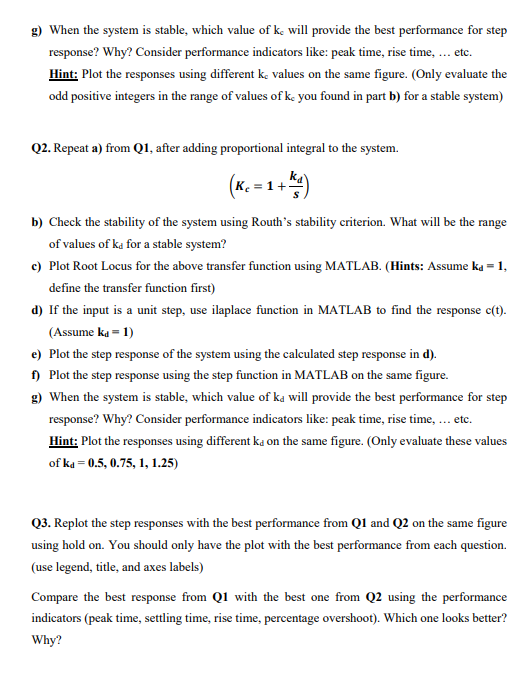R(s) 1 C(s) Ke s+1 s² + 2s + 1 a) Calculate the equivalent transfer function? b) Check the stability of the system using Routh's stability criterion. What will be the range of values of k, for a stable system?
R(s) 1 C(s) Ke s+1 s² + 2s + 1 a) Calculate the equivalent transfer function? b) Check the stability of the system using Routh's stability criterion. What will be the range of values of k, for a stable system?
Introductory Circuit Analysis (13th Edition)
13th Edition
ISBN:9780133923605
Author:Robert L. Boylestad
Publisher:Robert L. Boylestad
Chapter1: Introduction
Section: Chapter Questions
Problem 1P: Visit your local library (at school or home) and describe the extent to which it provides literature...
Related questions
Question

Transcribed Image Text:Q1. For the following system:
R(s)
1
1
C(s)
s+1
s2 + 2s + 1
a) Calculate the equivalent transfer function?
b) Check the stability of the system using Routh's stability criterion. What will be the range
of values of k, for a stable system?
c) Plot Root Locus for the above transfer function using MATLAB. (Hints: Assume ke =1,
define the transfer function first)
d) If the input is a unit step, use ilaplace function in MATLAB to find the response c(t).
(Assume k = 1)
e) Plot the step response of the system using the calculated step response in d).
f) Plot the step response using the step function in MATLAB on the same figure.

Transcribed Image Text:g) When the system is stable, which value of k, will provide the best performance for step
response? Why? Consider performance indicators like: peak time, rise time, ... etc.
Hint: Plot the responses using different k, values on the same figure. (Only evaluate the
odd positive integers in the range of values of k. you found in part b) for a stable system)
Q2. Repeat a) from Q1, after adding proportional integral to the system.
ka
(*. 1
b) Check the stability of the system using Routh's stability criterion. What will be the range
of values of ka for a stable system?
c) Plot Root Locus for the above transfer function using MATLAB. (Hints: Assume ka = 1,
define the transfer function first)
d) If the input is a unit step, use ilaplace function in MATLAB to find the response c(t).
(Assume ka = 1)
e) Plot the step response of the system using the calculated step response in d).
f) Plot the step response using the step function in MATLAB on the same figure.
g) When the system is stable, which value of ka will provide the best performance for step
response? Why? Consider performance indicators like: peak time, rise time, ... etc.
Hint: Plot the responses using different ka on the same figure. (Only evaluate these values
of ka = 0.5, 0.75, 1, 1.25)
Q3. Replot the step responses with the best performance from Q1 and Q2 on the same figure
using hold on. You should only have the plot with the best performance from each question.
(use legend, title, and axes labels)
Compare the best response from Q1 with the best one from Q2 using the performance
indicators (peak time, settling time, rise time, percentage overshoot). Which one looks better?
Why?
Expert Solution
This question has been solved!
Explore an expertly crafted, step-by-step solution for a thorough understanding of key concepts.
This is a popular solution!
Trending now
This is a popular solution!
Step by step
Solved in 4 steps with 3 images

Knowledge Booster
Learn more about
Need a deep-dive on the concept behind this application? Look no further. Learn more about this topic, electrical-engineering and related others by exploring similar questions and additional content below.Recommended textbooks for you

Introductory Circuit Analysis (13th Edition)
Electrical Engineering
ISBN:
9780133923605
Author:
Robert L. Boylestad
Publisher:
PEARSON

Delmar's Standard Textbook Of Electricity
Electrical Engineering
ISBN:
9781337900348
Author:
Stephen L. Herman
Publisher:
Cengage Learning

Programmable Logic Controllers
Electrical Engineering
ISBN:
9780073373843
Author:
Frank D. Petruzella
Publisher:
McGraw-Hill Education

Introductory Circuit Analysis (13th Edition)
Electrical Engineering
ISBN:
9780133923605
Author:
Robert L. Boylestad
Publisher:
PEARSON

Delmar's Standard Textbook Of Electricity
Electrical Engineering
ISBN:
9781337900348
Author:
Stephen L. Herman
Publisher:
Cengage Learning

Programmable Logic Controllers
Electrical Engineering
ISBN:
9780073373843
Author:
Frank D. Petruzella
Publisher:
McGraw-Hill Education

Fundamentals of Electric Circuits
Electrical Engineering
ISBN:
9780078028229
Author:
Charles K Alexander, Matthew Sadiku
Publisher:
McGraw-Hill Education

Electric Circuits. (11th Edition)
Electrical Engineering
ISBN:
9780134746968
Author:
James W. Nilsson, Susan Riedel
Publisher:
PEARSON

Engineering Electromagnetics
Electrical Engineering
ISBN:
9780078028151
Author:
Hayt, William H. (william Hart), Jr, BUCK, John A.
Publisher:
Mcgraw-hill Education,